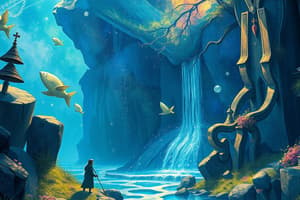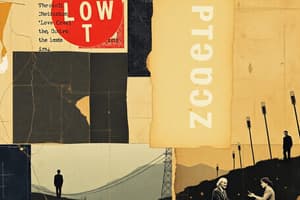Podcast
Questions and Answers
What is a key characteristic of narrative poetry?
What is a key characteristic of narrative poetry?
- It avoids using dialogue between characters.
- It is written solely in first-person point of view.
- It includes a beginning, middle, and ending. (correct)
- It primarily conveys emotions and feelings.
Which of the following describes the point of view in narrative poetry?
Which of the following describes the point of view in narrative poetry?
- It is limited to third-person omniscient narrators.
- It does not include any narrative perspective.
- It can only be first-person point of view.
- It may include both first-person and third-person perspectives. (correct)
In 'Biag ni Lam-ang', what event prompts Lam-ang to seek vengeance?
In 'Biag ni Lam-ang', what event prompts Lam-ang to seek vengeance?
- An attack on his village.
- A prophecy about his fate.
- His mother's disappearance.
- His father's death in battle. (correct)
What role does the narrator play in a narrative poem?
What role does the narrator play in a narrative poem?
Which element is NOT typically included in narrative poetry?
Which element is NOT typically included in narrative poetry?
Why is understanding the author's background significant in interpreting narrative poetry?
Why is understanding the author's background significant in interpreting narrative poetry?
What narrative element is vital for a story's resolution?
What narrative element is vital for a story's resolution?
What defines the setting in narrative poetry?
What defines the setting in narrative poetry?
What role does the antagonist play in a story?
What role does the antagonist play in a story?
Which of the following best describes the setting of a story?
Which of the following best describes the setting of a story?
What is the primary purpose of the plot in a story?
What is the primary purpose of the plot in a story?
Identify an example of character versus nature conflict.
Identify an example of character versus nature conflict.
What is the final event of a narrative called?
What is the final event of a narrative called?
How is rhyme used in narrative poems?
How is rhyme used in narrative poems?
Which rhyme pattern is illustrated by the example given?
Which rhyme pattern is illustrated by the example given?
Which of the following is NOT a type of conflict mentioned?
Which of the following is NOT a type of conflict mentioned?
What is imagery primarily used for in poetry?
What is imagery primarily used for in poetry?
Which of the following statements best defines hyperbole?
Which of the following statements best defines hyperbole?
Which type of narrative poetry typically recounts heroism and features extraordinary characters?
Which type of narrative poetry typically recounts heroism and features extraordinary characters?
What characterizes a ballad?
What characterizes a ballad?
What does an idyll typically describe?
What does an idyll typically describe?
In narrative poetry, what is primarily meant by the term 'verse novel'?
In narrative poetry, what is primarily meant by the term 'verse novel'?
In the excerpt from 'With Her Dreams of Happiness and My Heart in Grief', what primary emotion does the narrator express?
In the excerpt from 'With Her Dreams of Happiness and My Heart in Grief', what primary emotion does the narrator express?
How does dramatic poetry primarily convey its themes?
How does dramatic poetry primarily convey its themes?
What primarily distinguishes dramatic poetry from other forms of poetry?
What primarily distinguishes dramatic poetry from other forms of poetry?
In dramatic poetry, what aspect does the focus primarily center around?
In dramatic poetry, what aspect does the focus primarily center around?
What is a dramatic monologue?
What is a dramatic monologue?
Which of the following is a feature of a soliloquy?
Which of the following is a feature of a soliloquy?
What is the main emotional tone conveyed in the poem 'With Her Dreams of Happiness and My Heart in Grief'?
What is the main emotional tone conveyed in the poem 'With Her Dreams of Happiness and My Heart in Grief'?
What role does action play in dramatic poetry?
What role does action play in dramatic poetry?
In the context of dramatic poetry, how is the speaker's point of view significant?
In the context of dramatic poetry, how is the speaker's point of view significant?
Which of the following best summarizes the characteristics of dramatic poetry?
Which of the following best summarizes the characteristics of dramatic poetry?
Flashcards are hidden until you start studying
Study Notes
Narrative Poetry
- Narrative poetry tells a story with a beginning, middle, and end
- It includes characters, plot, conflict, and resolution
- Narrative poetry uses poetic devices such as meter and rhyme
Biographical Context
- Learn about the author's background and experiences
- Gather basic information to understand their writing perspective
Historical Context
- Understand the events that happened in the past
- Consider how past events relate to the author's reason for writing
Sociocultural Context
- Determine the social, economic, political and cultural aspects of the author's writing
- Examine the connections between the author's work and these aspects
Types of Narrative Poetry
- Epic: long poems recounting heroism often featuring kings, knights, or extraordinary people; Biag ni Lam-ang is an example
- Ballad: short stanza poetry narrating romance and adventure, often set to music
- Idyll: short narrative poem describing countryside life, scenes of nature, farming, or everyday life in a rural setting
- Lay: medieval lyric poetry telling stories of romance and chivalry, from France and Germany in 13th and 14th century
Point of View in Narrative Poetry
- First-person: The narrator is a character in the story using “I”, “me”, or “we”
- Third-person: The narrator is an observer using "he," "she," or "they"
Story Elements in Narrative Poetry
- Characters: People, animals, or things that perform actions and speak dialogues in the story
- Protagonist: Main character the story revolves around, whose decisions are affected by conflict
- Antagonist: Opposes the protagonist and creates conflict
- Setting: The time and place where the story takes place
- Plot: Connected sequence of events in the story, including problems faced and how they are solved
- Conflict: Struggle between two opposing forces, driving the story forward
- Character versus character: Conflict between two characters
- Character versus Self: Conflict within a character
- Character versus Nature: Conflict between a character and nature, often natural disasters
- Character versus Society: Conflict between a character and social norms and practices
- Resolution: The final event in the story, the concluding part of the narrative
Poetic Techniques in Narrative Poetry
- Rhyming Pattern: Repetition of syllables at the end of a line
- Imagery: Vivid description creating a clear picture for the reader
- Hyperbole: An exaggeration not meant to be taken literally
Dramatic Poetry
- Verse meant to be spoken and acted out, similar to narrative poetry because it tells a story
- A character speaks in dramatic poetry without exchange of words between characters
- Focus is on how the speaker is emotionally affected
Features of Dramatic Poetry
- Actions and speech are used to depict action and plot
- The focus is on how the speaker is emotionally affected
- Recited from a character’s point of view
Types of Dramatic Poetry
- Dramatic Monologue: Long speech delivered by a single character, revealing thoughts and emotions
- Soliloquy: A passage spoken aloud by a character but only heard by the speaker, revealing thoughts and emotions
Studying That Suits You
Use AI to generate personalized quizzes and flashcards to suit your learning preferences.




